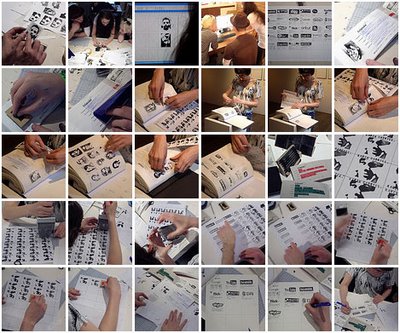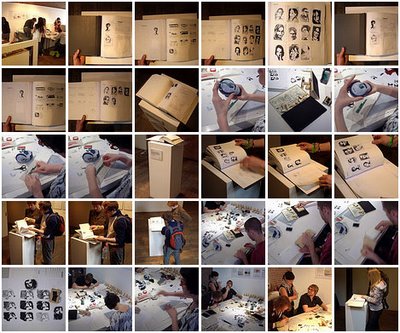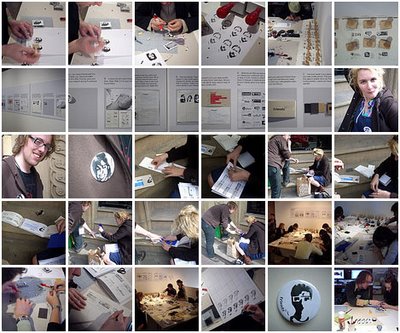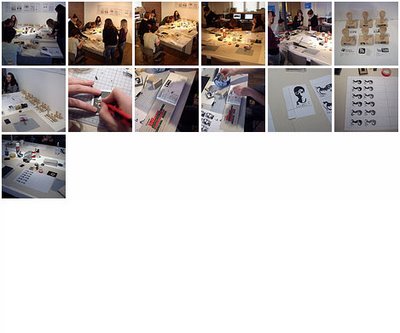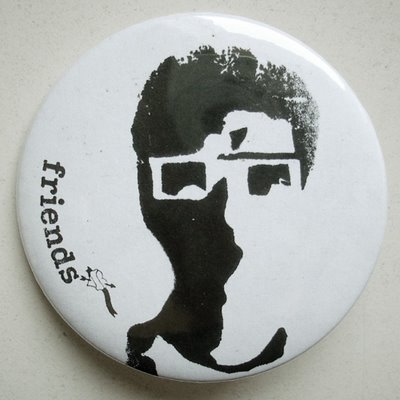Archive for the ‘friends’ tag
Solitude
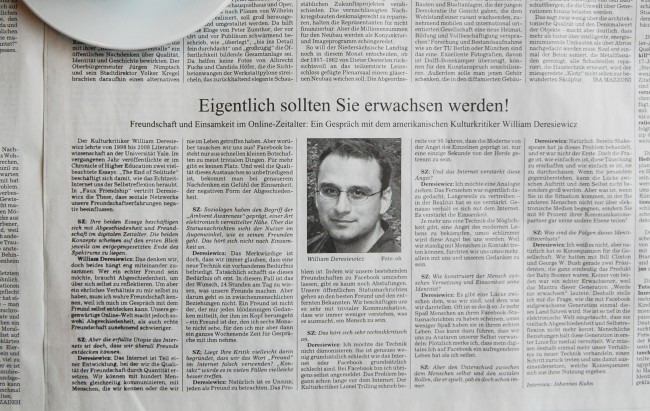 I agree on most of what he says and many of these questions were raised during the “Friends” workshop I ran at Futuresonic in 2008 . Unfortunately this won t reach my 359 ex-facebook friends any more… haha. I quit 2 days ago ….
I agree on most of what he says and many of these questions were raised during the “Friends” workshop I ran at Futuresonic in 2008 . Unfortunately this won t reach my 359 ex-facebook friends any more… haha. I quit 2 days ago ….
Marriage Market
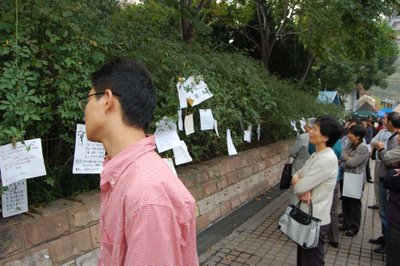
There has been a lot of discussion on how we can reclaim, revive and engage Public Space in Europe/West. It was very interesting to see how Public Space is still naturally used in Shanghai, China. The picture shows a kind of public marriage market wich takes place once a week (month?) in the very centre of Shanghai on People’s Square. Parents advertise their grown up kids by short notes and try to find a good match for them. A very classic offline social network, serious dating platform. :-)
eARTS Shanghai
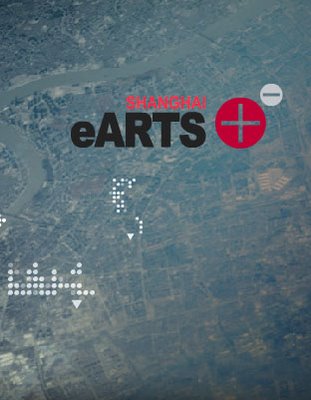
I’ll be be part of the workshop “Urban Space. Time to Play” 19th – 22th Oct. next week at eARTS Shanghai. I am looking forward to it and I am curious to test China for some paper based realtime urban adventure action. Stay tuned! More info
Essay on “Friends”
![]()
Thanks to Theo Honohan who did write an interesting essay on my latest project “Friends“.
Friends
Aram Bartholl’s workshop Friends actualizes the processes of abstraction and distancing which are involved in the construction of contemporary social networking websites. By turning these immaterial processes into physical action and representations, the work offers a critical model of current software practice on the web.
Under the general name of Web 2.0, social networking sites provide various facilities for publishing content on the web. In the case of Flickr, the content is images; in the case of Delicious, bookmarks; Last.fm, music playlists; Facebook and myspace, general personal information. The material published on these sites is often not particularly interesting to a general viewer. Its value consists primarily in the availability of information to friends. The ability to explicitly create links of friendship between users is therefore the central feature of these sites, and the feature from which the name “Social Networking” is derived.
Bartholl’s work, which could have been titled Friends?, calls into question the value and meaning of these explicit declarations of friendship. For one thing, the mechanical nature of the process gives it a simplistic quality. Two people are either friends or they are not, according to the system. This binary coding of relationships leaves no room for gradations of familiarity from intimacy to acquaintance. This initial observation is enriched by the level of detail into which the piece goes in representing the internal abstractions of a site such as Facebook. Each level of abstraction can be seen as a distancing from reality and the site of a possible slippage between image and actuality.
The process of creating a personal profile in the system begins with a digital photograph. This image of the user is transformed digitally into a black and white stencil. Affixing a printout of the stencil to a rubber stamp, the user cuts out the white areas to create a reusable stamp of their own image. In creating a reusable stamp, the work captures the infinitely reproduceable nature of a digital image. The image can appear over and over within the “site”, rather than existing just as a single original.
The creation of a profile continues with the preparation of a blank booklet for use as a register of friends. The booklet gains structure entirely through a series of rubber stamps which mimic the process of formatting a blank computer database. Data slots are created for name, email address and website, and a further grid of spaces is prepared to hold references to the user’s details on other social networking sites. The process of registering friends involves stamping, carbon-paper transfers, and the gluing of pre-prepared adhesive stamps into the “data slots”. The complexity of this process parallels the degree of indirection and formality involved in the software behind a social networking site, if not the experience of creating friends on Facebook. Bartholl, by calling attention to this complexity, illustrates the degree to which the information we share fits into an elaborate structure.
The process of adding friends to one’s personal profile is a reciprocal one; each of you ends up with a new page in the booklet showing the details of your new friend. The piece has another component, however, a central volume which includes a page for each user which records their friends (affixed as stamps) and pending friend requests (unglued stamps are held in a plastic pouch.) The analogy here is with a central database on a system such as Facebook. The whole graph of relationships is held in one place, rather than being stored in private, personall relations between profiles/booklets. This central volume is of course the way social networking systems are actually implemented, while the “peer-to-peer” architecture of the booklets, while offering potential advantages in security and privacy, has not been pursued (except, to a degree, in the case of Skype.)
The presence of a central database is a reminder of the industrial scale and automation of the process. Bartholls’ work problematizes the mass production of social contacts. While the concrete formal techniques of the workshop (sheets of repeated portraits) evoke images of an artistic practice such as that of Andy Warhol’s “Factory”, the abstract structure revealed by the development of a profile and network of friends shows the potentially dehumanizing nature of social networks. The choice of black and white for all representations produces an impression of direct simplicity but also unyielding control. The idea of a computerized social network, in the end, is a formalism, while social relationships are blurry, vital and inevitably exceed the terms of any fixed representation.
23 September 2008
"Friends" documentation online!
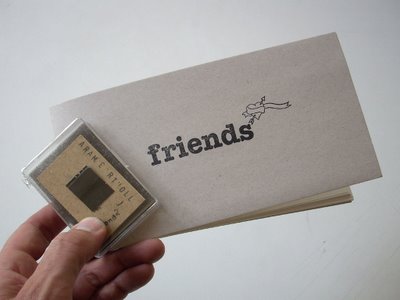
I just finished the documentation for my latest project “Friends” which has been premiered at Futuresonic 2008 a month ago. It was a lot of fun and it came out really well. Friends will be shown again during Futuresonic-Leeds and Futuresonic-London sometime 2008/2009. Don’t miss to become part of the Friends network. ;-)
Credits:
– Thanks to Veronika Becker and Holger Lindmüller for advice, design and production assistance during preparation phase in Berlin.
– Thanks to Kit Turner (Futuresonic art production assistance) and Ben Harding (Futuresonic tech. and exhibition architecture) for the production in Manchester.
– Thanks to my exellent Friends workshop assistance Charlotte Barnes and to the volunteers: Josephine, Dan, Sofia, Maya … among others.
– Thanks to the whole Futuresonic 2008 team for support!
"Friends" pics!
The Factory
Friendsnetwork "online"!
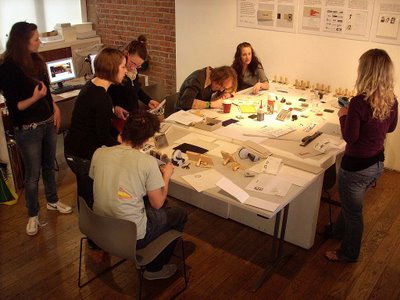
New project “Friends” started today at Futuresonic. Finally the workshop is up and running. If you are in Manchester drop by CUBE gallery and get your own Friends book.
All recent posts on “Friends”.
Friends
The project Friends is a workshop which translates the so-called social web – online services such as Facebook, Myspace, etc. – into a paper-based form in physical space.All workshop participants contribute a profile page to the big Friends Book and make their own personal friends booklet in which to collect as many friends as possible. With their own hand-made profile photo stamp and a large amount of prefabricated web 2.0 service stamps, users trade among each other information about their favorite online services and web activities. In order to be recognized as Friends workshop participants, users can wear a button with their own profile photo or display their Web 2.0 preferences on Friends Tattoos.
Social networks in the internet, which have become hugely popular over the last few years, have given the term “friend” a completely new meaning. In contrast to the usually restricted and time-consuming circle of friends in everyday life, in the internet it is possible to find a large number of friends quickly with just a few clicks.And only a few of these friends are actually personally known by the user. Without a great deal of effort it is possible to have hundreds, thousands or even hundreds of thousands of friends in the Internet. Who has the most friends? Who is the best-known and the most often to be seen? The development of the internet in recent years enables the individual to gratify his/her desire for recognition and attention in quite a new way.
With reference to the classic German poetry album or the friendship book in the USA, the Friends workshop takes this development as the central theme and opens a debate over the many-layered types from friendship. The time-honored paper-based technology and tools used in the workshop as well as the handicraft skills of its participants contrast with the screen-limited but highly efficient online world of the social networks. In contrast to the obvious open contact with private information in the social web, the classic paper document conceals a high degree of obligation and protects privacy.The data from the web services documented on paper during the Friends workshop pose anew the question of the private and public nature of web identities.
Who is my friend? How well do we know each other? Where do we meet?
How does the Social Web effect inter-personal relationships?
Aram Bartholl 2008
agoasi
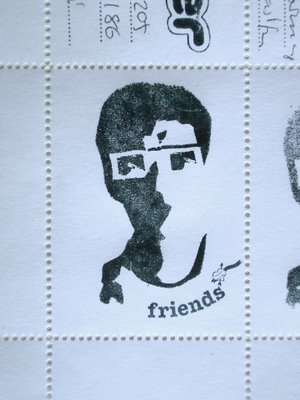
“Friends” stamps
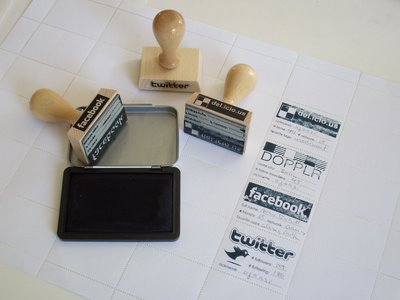
Stamps for “Friends” workshop at Futuresonic arrived. :-)
(more than 30)
Join the Friends network at
Futuresonic 2008!
Get to know cool new friends and hook up. Find out which online social networks they belong to. Extend your list of friends and let new people discover you. Get ready and take offline networking to the next level!
Join the Friends workshop to create your own paper profile page in the ground breaking big Friends network book. And take away your personal Friends booklet, to carry on collecting new friends around the city. Create your handmade profile picture and leave your mark with special stamps and ink on all your friends’ booklets. A wide range of tools and materials are provided. Show off your Web 2.0 identity in paper mode!
Instructions:
1. Sample your personal Friends booklet from high end manufactured paper sheets to start your unforgettable collection of new friends!
2. Use your hands! Cut a stamp with your web profile picture. This personal tool plays a central role in all Friends communication. Leave your traces in real life!
3. Connect! Coin your basic profile data by using Dymo label tape. All your friends can get an easy carbon copy of your basic contact info!
4. What Social Web services are you on? Stamp and customize your personal Web 2.0 info. Create a collection of Web 2.0 stamps to distribute and inform all your friends about your online activities.
5. Contribute to the big, public and constantly growing Friends book. All users of the Friends network have a profile page here! Take a look at who is already part of it! Create your personal profile page and share your digital life!
6. Find new friends! Place friend requests on user profile pages and exchange info directly via carbon copy and Web2.0 stamps. Collect and share your online identity in your Friends booklet.
7. “Yes, I am using Friends and it is great!” Create your personal button badge to find other Friends users and extend your network during Futuresonic 2008.
8. Customize and wear Friends tattoos. Wear Web2.0 on your skin! Inhale Social Web!
